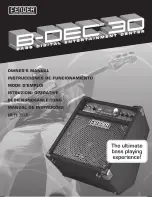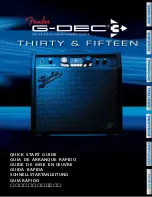
1a
1b
1c
1d
2a
2b
3a
ON
PRT
ON
PRT
ON
PRT
1
2
3
1
Posizione dell’amplificatore.
Non posizionare l’amplificatore sotto
moquette o in vani con superfici a contatto
del dissipatore che non permetterebbero un
adeguato scambio di calore.
E’ importante anche il verso di installazione
dell’amplificatore, la sua forma è
appositamente studiata per collocazioni
come quelle indicate nelle (fig. a,b,c,) che
garantiscono la migliore dissipazione di
calore. La posizione indicata dalla (fig. d) è
assolutamente da evitare poichè non
permette un regolare funzionamento dello
stesso. Gli amplificatori
steg
sono
comunque protetti contro i surriscaldamenti
e quando le protezioni entrano in funzione
(85°C) l’amplificatore smette di funzionare
per riprendere appena la temperatura del
dissipatore scende di qualche grado sotto la
soglia di protezione.
2
Fissaggio dell’amplificatore.
Per prevenire danni alle persone,
all’amplificatore o alla vettura fissate bene
l’amplificatore, in un punto sicuro. Gli
amplificatori
QMOSII
si avvalgono di un
sistema di fissaggio semplice ed efficace (fig.
a). I quattro piedini forniti a corredo vanno
inseriti lungo la scanalatura del dissipatore e
possono essere posizionati in un punto
qualsiasi della lunghezza dello stesso (fig.b)
così da permettere il fissaggio anche su
superfici che non consentono quattro fori a
distanza regolare. Stabilite le posizioni dei
piedini basta bloccarli avvitando le viti
autofilettanti fornite a corredo.
3
Stato dell’amplificatore (STATUS).
Sul pannello frontale dell’ amplificatore si
trovano i due LED di verifica dello stato di
funzionamento dell’amplificatore (fig. a).
1- VERDE: In funzione.
2-VERDE+ROSSO: Stato di muting per
protezione termica o cortocircuito sulla linea
altoparlanti.
3 - R O S S O : M a l f u n z i o n a m e n t o
dell’amplificatore che smette di funzionare
per prevenire danni agli altri componenti
dell’impianto collegati all’uscita. Se
l’amplificatore rimane in questo stato
consigliamo di rivolgersi al rivenditore-
.
steg
1
Amplifier position.
Do not place the amplifier under moquettes
or in spaces with surfaces in contact with the
heat-sink, since this would prevent adequate
heat exchange.
Also the direction of installation of the
amplifier is important; its shape is specially
designed for positioning as shown in the
which guarantees the best heat
dissipation. The position as shown in
is absolutely to be avoided, since it does not
allow regular functioning of the amplifier.
amplifiers are, however, protected
against overheating; when the protections
are activated (85°C), the amplifier stops
working and starts again only after the
temperature of the heat-sink goes down to a
few degrees below the protection threshold.
2
Fixing the amplifier.
To prevent damage to persons, the amplifier
or the vehicle, firmly fix the amplifier in a
safe place. The
amplifiers can be
fitted in a simple and efficient way (fig. a).
The four feet provided are inserted along the
heat-sink groove and can be positioned at
any point along its length (fig. b), and can
thus also be fitted onto surfaces where four
evenly-spaced holes cannot be made. Once
the foot positions have been established,
lock them by screwing down the self-tapping
screws provided.
3
Amplifier state (STATUS).
On the front panel of the amplifier are two
LEDs which indicate the amplifier operating
state (fig. a)
1-GREEN: on.
2-GREEN+RED: Muting state for thermal
cut-out or short-circuit on the speaker line.
3-RED: Malfunctioning of the amplifier
which stops working to prevent damage to
the other system components connected to
the output. Should the amplifier remain in
this state, it is advisable to contact a
dealer.
(fig.
a,b,c,)
(fig.d)
QMOSII
steg
steg
1
Position de l'amplificateur.
Ne pas placer l'amplificateur sous de la
moquette ou dans des emplacements ayant
des surfaces en contact avec le dissipateur,
car cela empêcherait un échange de chaleur
approprié.
Le sens d'installation de l'amplificateur est
également important. En effet, sa forme est
spécialement étudiée pour des installations
comme celles indiquées sur les
garantissant la meilleure dissipation de la
chaleur. La position indiquée sur la
doit impérativement être évitée parce
qu'elle ne permet pas un fonctionnement
régulier de ce dernier. Les amplificateurs
sont protégés contre les é
chauffements et lorsque les protections
s'enclenchent (85°C) l'amplificateur arrête
de fonctionner pour reprendre dès que la
température du dissipateur descend de
quelques degrés au-dessous du seuil de
protection.
2
Fixation de l'amplificateur.
Pour éviter des accidents aux personnes et
de détériorer l'amplificateur ou à la voiture, il
faut bien fixer l'amplificateur dans un point
sûr. Les amplificateurs
ont un
système de fixation simple et efficace (fig. a).
Les quatre pieds fournis dans la confection
doivent être introduits dans la rainure du
dissipateur et peuvent être placés à
n'importe quel endroit le long de ce dernier
(fig. b) permettant ainsi la fixation, même sur
des surfaces ne consentant pas quatre trous à
distance régulière. Après avoir établi les
positions des pieds il nereste plus qu'à les
bloquer en vissant les vis autotaraudeuses
fournies en équipement.
3
Etat de l'amplificateur (STATUS).
Deux VOYANTS lumineux, pour le contrôle
d e l ' é t a t d e f o n c t i o n n e m e n t d e
l'amplificateur, se trouvent sur le panneau
avant de ce dernier. (fig. a)
1- VERTÊ: en fonction.
2-VERT+ROUGEÊ: Etat d'alarme pour
protection thermique ou court-circuit sur la
ligne des haut-parleurs.
3-ROUGEÊ: dysfonctionnement de
l'amplificateur qui s'arrête de fonctionner
pour éviter toute détérioration aux autres
composants de l'installation reliés à la sortie.
Si l'amplificateur reste cette situation il est
conseillé de contacter le revendeur
.
(fig. a,b,c,)
(fig.d)
QMOSII
steg
steg
1
Position des Verstärkers.
Positionieren Sie den Verstärker nicht unter
Teppichboden oder in Fächern, die mit dem
Wärmedissipator in Kontakt kommen und
eine angemessene Abstrahlung der Wärme
verhindern.
Auch die Einbaurichtung des Verstärkers ist
wichtig; seine Form wurde eigens für die
(Abb. a,b,c) Installationsweisen entwickelt,
d i e d i e b e s t e W ä r m e a b s t r a h l u n g
gewährleisten. Die auf der (Abb. d) gezeigte
Position muss unbedingt vermieden
werden, da sie keinen ordnungsgemäßen
Betrieb des Verstärkers gestattet. Die
Verstärker
sind gegen Überhitzung
g e s c h ü t z t u n d w e n n d i e
Schutzvorrichtungen eingreifen (85°C), wird
der Verstärker abgeschaltet; er wird wieder
eingeschaltet, sobald die Temperatur des
Dissipators wieder um einige Grad unter der
Schutzschwelle abfällt.
2
Anbringung des Verstärkers.
Befestigen Sie den Verstärker zur
Vermeidung von Schäden an Personen, am
Verstärker oder am Fahrzeug an einem
sicheren Punkt. Die Verstärker
weisen ein einfaches und effizientes
Befestigungssystem auf (Abb. a). Die vier
mitgelieferten Füßchen werden in die
Kehlen des Dissipators eingesteckt und
können an einem beliebigen Punkt auf der
Länge desselben positioniert werden
(Abb.b), um die Befestigung auch auf
Oberflächen zu gestatten, die keine vier
Bohrungen mit gleichmäßigem Abstand
gestatten. Nach dem Festlegen der
Positionen der Füßchen müssen sie lediglich
mit den mitgelieferten selbstschneidenden
Schrauben arretiert werden.
3
Status des Verstärkers (STATUS).
Auf dem Frontpaneel des Verstärkers
befinden sich zwei Leds für den
Betriebsstatus des Verstärkers (Abb. a)
1 - GRÜN: In Betrieb.
2-GRÜN+ROT: Muting-Status aufgrund
von Überhitzung oder Kurzschluss der
Lautsprecherleitung.
3-ROT: Funktionsstörung des Verstärkers,
der abgeschaltet wird, um Schäden an
anderen am Ausgang angeschlossenen
Komponenten der Anlage zu verhindern.
Wenden Sie sich an Ihren
-Händler,
wenn der Verstärker in diesem Status bleibt.
steg
steg
QMOSII
1
Ubicación del amplificador
No instalar el amplificador debajo de
moquetas o en alojamientos con superficies
a contacto con el disipador, que no
permitirían un apropiado intercambio de
calor.
También es importante el sentido de
instalación del amplificador, dado que su
forma ha sido especialmente proyectada
para instalaciones como las indicadas en las
(fig.a,b,c), que garantizan la mejor
dispersión del calor. La posición indicada en
la (fig. d) debe ser absolutamente evitada,
d a d o q u e n o p e r m i t e u n b u e n
funcionamiento del aparato. De todos
modos, los amplificadores
están
protegidos contra los recalentamientos y,
cuando los dispositivos de protección entran
en funcionamiento (85°C), el amplificador
se detiene, retomando más tarde su
funcionamiento ni bien la temperatura del
disipador descienda algunos grados por
debajo del límite de protección.
2
Fijación del amplificador
Para prevenir daños a las personas, al
aparato o al automóvil, es importante fijar
bien el amplificador en un punto seguro.
Los amplificadores
están dotados
de un sistema de fijación sencillo y eficaz
(fig. a). Los cuatro pies que se entregan con
el equipamiento se aplican a lo largo de la
ranura del disipador y se fijan en cualquier
punto de la misma (fig. b), para facilitar la
instalación aún sobre superficies que no
permiten realizar cuatro orificios a distancias
regulares. Una vez establecidas las
posiciones de los pies, es suficiente trabarlos
ajustando los tornillos que se entregan con el
equipamiento.
3
Estado del amplificador (STATUS).
Sobre el panel delantero del amplificador se
encuentran los dos LED de control del
estado de funcionamiento del amplificador:
(fig.a )
1 - VERDE: En funcionamiento.
2-VERDE+ROJO: Estado de "muting"
(reducción del volumen sonoro) como
protección térmica o de cortocircuito en la
línea de los altoparlantes.
3-ROJO: Desperfecto del amplificador, que
deja de funcionar para prevenir dañ
os a los otros componentes del equipo
conectados a la salida. Si el amplificador
permanece en este estado se aconseja
ponerse en contacto con el revendedor
.
steg
steg
QMOSII
STATUS
pag
. 5


































